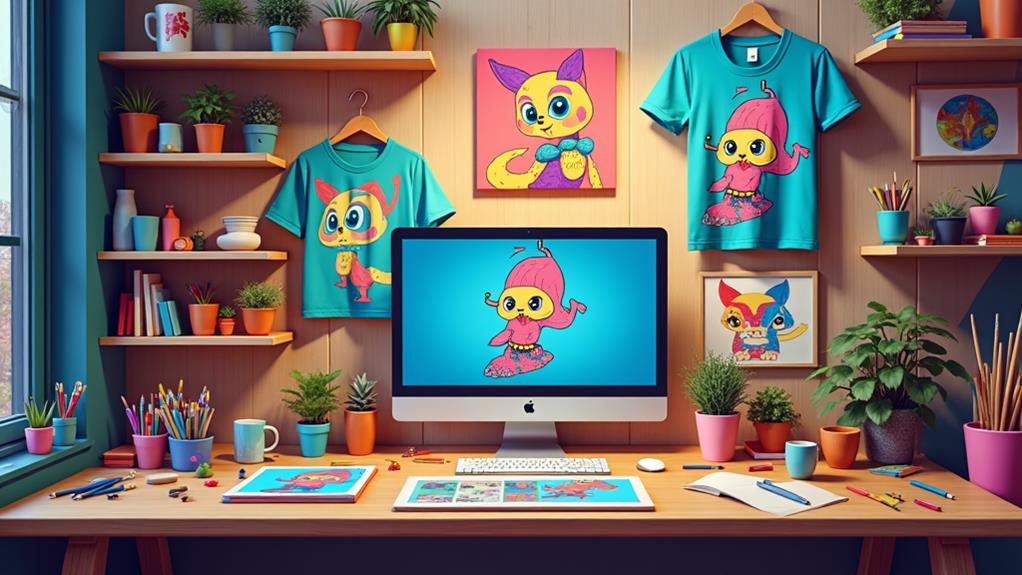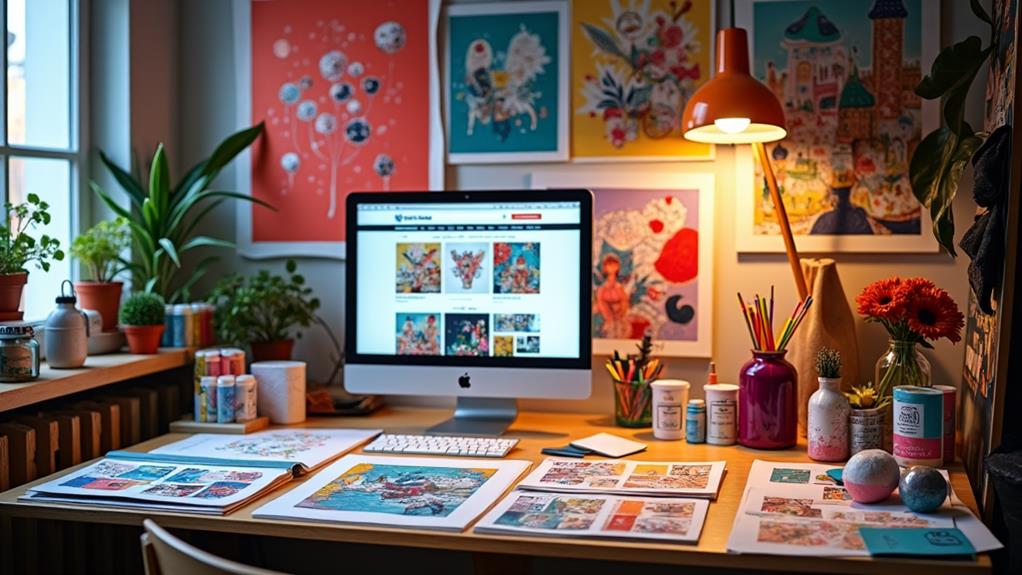
Turning your unique artistic creations into marketable products through print-on-demand (POD) services offers a strategic pathway to expand your revenue streams while reaching a global audience. By eliminating upfront inventory costs, artists can experiment with diverse product offerings, from wall decor to custom apparel, capturing niche markets and seasonal trends. Leveraging social media and optimizing for SEO enhances visibility and customer engagement. Pricing strategies and quality control are instrumental in maintaining profitability and customer satisfaction. Engaging marketing and storytelling further deepen connections with your audience, setting the stage for continued growth and success. Here's how to get started successfully.
Key Takeaways
- Eliminate upfront inventory costs by using print-on-demand services that produce and ship products only upon order.
- Expand your product offerings by experimenting with various designs on items like wall decor, custom apparel, and niche market products.
- Utilize social media platforms to connect with a global audience and showcase your artwork effectively.
- Conduct market research to test product options and refine offerings based on customer preferences without incurring inventory costs.
- Implement strategic keyword research and SEO practices to enhance the visibility of your online store and attract your target audience.
Benefits of Print-on-Demand
In the dynamic landscape of the art industry, print-on-demand (POD) offers a myriad of benefits that can transform an artist's business model. One of the most considerable advantages is the elimination of upfront inventory costs. Artists no longer need to invest in bulk stock, as products are produced only upon order placement. This market trend allows for agile adaptation to consumer preferences without financial risk.
Additionally, niche targeting can lead to higher conversion rates by addressing specific customer needs and creating indispensable market positions.
Moreover, POD platforms enable artists to easily expand their product offerings and experiment with various designs across multiple merchandise types. The ability to test different artworks on items such as apparel, home decor, and accessories without the burden of unsold inventory enhances an artist's versatility and market appeal.
Passive income generation is another strategic benefit of POD. Once initial setup and design uploads are complete, artists can earn consistently with minimal ongoing effort. This model is not only efficient but also scalable, providing a sustainable revenue stream.
Additionally, POD services provide global audience access, considerably increasing an artist's potential customer base. Platform comparisons reveal that many POD providers offer high-quality production and reliable shipping solutions.
These features allow artists to concentrate on their creative endeavors, confident in their operational support.
Choosing the Right Products
With the advantages of print-on-demand clear, artists must now strategically select the products that will best showcase their creativity and resonate with their target audience. Wall decor remains a popular choice, offering a versatile canvas for diverse types of art prints that appeal to various home aesthetics and interior design tastes.
Custom apparel, particularly graphic tees and hoodies, is another lucrative option. The print-on-demand t-shirt market, valued at $4.319 million in 2022 and projected to reach $7.57 billion by 2028, underscores the significant potential in this category. Platforms like Etsy and Shopify provide excellent opportunities for artists to market their custom apparel and other print-on-demand products effectively.
Expanding product variety can also attract niche markets. Unique items such as puzzles, tote bags, and all-over print products can differentiate an artist's offerings. These products cater to customers seeking distinctive and personalized items, thereby expanding an artist's reach.
Additionally, incorporating seasonal product offerings, like holiday-themed items, can drive sales during peak shopping periods and maintain customer engagement throughout the year.
Market research is essential in this process. By testing various product options without upfront inventory costs, artists can experiment and refine their offerings based on customer preferences and sales performance, ensuring a more targeted and effective product lineup.
Engaging Your Target Audience
Engaging your target audience begins with understanding their emotional connections to art, which often outweigh stylistic preferences.
Leveraging social media platforms like Instagram and Pinterest can help artists connect with a global audience and showcase their work effectively.
Capitalizing on seasonal sales opportunities, particularly during holidays, can greatly boost revenue by offering giftable art products that resonate with buyers.
Strategically aligning your offerings with these emotional and seasonal dynamics guarantees enhanced market appeal and customer engagement.
Emotional Connection Matters
Why do art buyers often prioritize an emotional connection with artwork over the artist's fame or style? This preference underscores the importance of storytelling techniques and personal narratives in marketing strategies. Consumers are drawn to pieces that resonate with their experiences, aspirations, or memories.
By incorporating storytelling techniques, artists can create a compelling narrative around their work that enhances its emotional appeal. For instance, illustrative designs can leverage personal narratives to connect with fans of graphic novels and manga. A story behind a piece can make it more relatable, expanding its appeal when featured on everyday items.
Similarly, interior design enthusiasts often look for wall art that tells a story or enhances their living spaces aesthetically. Contextualizing art within a decorative setting can showcase its potential, making it more attractive to buyers.
Targeting niche art lovers also requires a nuanced approach. Themes like nature or retro styles naturally lend themselves to rich storytelling, helping to engage specific customer segments. By tapping into these targeted narratives, artists can foster deeper connections with their audience, driving engagement and sales.
Ultimately, the emotional connection facilitated by storytelling can greatly amplify the market reach of print-on-demand art products.
Seasonal Sales Opportunities
Understanding the power of emotional connections, artists can strategically harness seasonal sales opportunities to further engage their target audience. Seasonal sales, particularly those centered around holiday themes, can greatly attract customer interest during peak shopping periods.
Art buyers are drawn to pieces that evoke specific emotions, and seasonal art that resonates with themes like Christmas, Halloween, or Valentine's Day can enhance this connection, driving increased engagement and sales.
Offering unique, limited editions of seasonal products can create a sense of urgency among buyers. The limited-time availability encourages customers to make swift purchase decisions, capitalizing on the fear of missing out. This not only boosts immediate sales but also builds anticipation and excitement around future seasonal offerings.
Leveraging trending keywords related to specific seasons in product descriptions can optimize search engine visibility, driving more traffic to your online store. Higher visibility translates to more potential buyers discovering your work during high-traffic shopping periods.
Additionally, engaging with online communities and utilizing social media platforms to showcase your seasonal products can further extend your reach. By tapping into these strategic insights, artists can effectively turn seasonal opportunities into a powerful tool for audience engagement and sales growth.
Leveraging Keywords and SEO
Optimizing visibility in the digital marketplace is vital for artists utilizing print-on-demand services. One of the most effective strategies is through diligent keyword research and SEO optimization. By identifying trending keywords relevant to your artwork, you can greatly enhance your visibility in online searches, driving more traffic to your products.
Tools like Google Keyword Planner or Ubersuggest can assist in uncovering popular search terms that resonate with your target audience. Additionally, it's important to guarantee your site has fast loading speeds and mobile-friendly designs to improve user experience and SEO performance.
Incorporating these relevant keywords into your product descriptions and titles is essential. This practice not only boosts your search engine optimization but also makes it easier for potential customers to discover your art. Moreover, monitoring seasonal trends and integrating keywords related to holidays or events can tailor your offerings to market demand, maximizing relevance and sales potential.
Additionally, utilizing social media hashtags with targeted keywords can amplify engagement and reach, further increasing your artwork's visibility. It's also important to regularly update and optimize your product listings with new, trending keywords. This continuous refinement helps improve your rankings on search engines and e-commerce platforms like Etsy, guaranteeing your art remains discoverable and competitive in a dynamic digital landscape.
Effective Marketing Strategies

Achieving ideal visibility through strategic keyword integration and SEO measures sets a strong foundation for artists in the print-on-demand sector. However, effective marketing strategies extend beyond these tactics. Utilizing social media platforms like Instagram and TikTok is essential.
Artists should showcase their artwork and products, engaging with current trends to attract a wider audience and bolster visibility. Hashtags, stories, and viral challenges can greatly amplify reach.
SEO remains important; incorporating relevant keywords into product descriptions enhances search engine rankings, improving discoverability on platforms like Etsy and Google. To further enhance visibility, artists should build a digital platform using free resources like WordPress for a more robust online presence.
Complementing these efforts, email marketing proves essential. Regular updates on new product launches, promotions, and exclusive offers help maintain a direct connection with your customer base and foster loyalty.
Moreover, influencer collaborations can be a game-changer. Partnering with influencers within the art community expands your reach and enhances credibility. Their endorsement can greatly raise brand awareness, attracting new customers.
Finally, consider hosting viral giveaways or limited-time discounts. Given that 90% of online shoppers utilize coupons, these strategies can drive considerable traffic to your store and boost sales.
Combining these elements, artists can effectively navigate the competitive print-on-demand market.
Pricing and Profit Margins
Setting the right prices is essential for artists in the print-on-demand market to guarantee both competitiveness and profitability. Conducting a thorough competitive analysis is fundamental to understand how similar products are priced in the market. This guarantees your offerings are appealing without undervaluing your work.
Enhancing your product pages with key product features can also add value, justifying higher pricing. Below are strategic insights for optimizing your pricing strategies:
- Analyze Competitor Pricing: Researching competitor pricing helps you set prices that are competitive yet profitable. This involves examining similar products to gauge the current market rates.
- Consider Production Costs: Factor in the production costs from your print-on-demand provider. This includes printing, materials, and shipping costs. Making certain these are covered while maintaining a healthy profit margin is critical.
- Tiered Pricing: Offering tiered pricing for different product types caters to various budgets. This approach broadens your customer base, making your art accessible to a wider audience.
- Regular Reassessment: Continuously reassess your pricing strategies based on market trends and customer feedback. This adaptability can optimize sales and profitability over time.
Additionally, implementing discounts or promotions during peak shopping seasons can attract more customers. With 90% of online shoppers utilizing coupons, such tactics can greatly enhance your sales volume.
Ensuring Quality and Customer Satisfaction

In the domain of print-on-demand for artists, guaranteeing quality and customer satisfaction is vital to building a loyal customer base and sustaining long-term success. Quality assurance begins with selecting reliable print-on-demand partners known for high-quality prints and products. Regularly reviewing product samples is important to maintain consistency in quality, making certain that each piece meets the artist's standards and customer expectations.
Additionally, artists should consider leveraging social media marketing strategies to increase visibility and engage with their audience effectively.
Strategically, enhancing the unboxing experience through standard packaging can greatly impact customer satisfaction. A well-thought-out packaging strategy not only protects the product but also boosts the customer's first impression, fostering repeat purchases.
Customer feedback serves as an essential tool for continuous improvement. By actively gathering and analyzing feedback, artists can pinpoint areas needing enhancement in their product offerings. This data-driven approach allows for informed decisions about design adjustments and material choices, aligning final products with customer preferences in both aesthetics and durability.
Testing various materials and formats guarantees that the products resonate well with the intended audience while meeting durability standards.
Moreover, prompt responses to customer inquiries and feedback establish trust and build strong relationships, which are fundamental for long-term customer loyalty. Essentially, a commitment to quality assurance and attentive customer feedback integration is key to thriving in the print-on-demand market.
Frequently Asked Questions
How Do I Turn My Art Into Products?
To turn your art into products, use print-on-demand platforms to create artistic merchandise. Guarantee compliance with size and file requirements, utilize product customization options, and implement strategic pricing and marketing techniques for enhanced visibility and customer engagement.
How Do I Sell My Art Prints on Demand?
To sell your art prints on demand, choose reputable art print marketplaces and employ effective online selling strategies. Guarantee high-quality uploads, optimize listings with relevant keywords, set competitive pricing, and actively promote your products via social media and email marketing.
Is Print on Demand Profitable for Artists?
Yes, print on demand can be profitable for artists. By leveraging favorable profit margins and aligning product offerings with market demand, artists can effectively capitalize on this business model, maximizing revenue while minimizing upfront investment and inventory risks.
How Do I Merchandise My Artwork?
To merchandise your artwork effectively, explore art licensing opportunities and select diverse product types such as apparel, home decor, and accessories. Continuously analyze market trends, optimize product listings, and adapt your offerings to align with customer preferences.
Conclusion
The adoption of print-on-demand for artists offers numerous advantages including minimized financial risk, expanded product offerings, and streamlined operations. By carefully selecting products, targeting specific audiences, leveraging SEO, and implementing effective marketing strategies, artists can enhance their commercial success. Pricing strategies and maintaining quality are critical to ensuring customer satisfaction and profitability. This approach provides a sustainable and scalable model for artists seeking to monetize their creativity in a competitive market landscape.
Leave a Reply